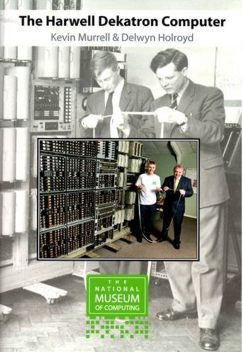| The Harwell Dekatron Computer |
|
Author:Kevin Murrell & Delwyn Holroyd This booklet makes a good souvenir for visitors to the UK's National Museum of Computing, but will it find a wider audience?
This book tells the story of the discovery and restoration of an early digital computer that according to the back jacket blurb: has led a charmed life and, instead of ending up on a skip or being recycled, has survived across seven decades. Harwell was the home of the UK's Atomic Energy Research Establishment and the Dekatron in its name refers to the counting tubes that enabled it to do arithmetic in base ten rather than binary. The book's authors are the two people most concerned with the project to breathe new life into a computer that first operated in 1951: Kevin Murrell who was responsible for identifying the forgotten computer from photographs taken in a museum storeroom and Delwyn Holroyd who led the restoration team. They adopt an almost conversational style throughout the book. This an the inclusion of photographs on almost every page make for an easy read.
There isn't a chapter structure to this book but it is in two distinct sections - the history of the computer and then notes on its distinct technology and details of the restoration. The first page gives a succinct outline of the four stages of the career of the Harwell Dekatron Computer which are then expanded on over the following twenty seven pages together with material that provides both context and detail. As I Programmer reported when the restored machine was switched on the UK's National Museum of Computing the Harwell Dekatron was originally built between 1949 and 1951 to help atomic scientists at the UK Atomic Energy Research Establishment (AERE) in Harwell, Oxfordshire. Its task was to perform complex calculations that were previously done by human mathematicians called "hand computers". When it become redundant at Harwell, it went to Wolverhampton and Staffordshire Technical College, which although the book doesn't seem to explicitly state this, led to it being renamed the WITCH (Wolverhampton Instrument for Teaching Computation from Harwell). It was used for teaching computing until 1973 when it went to the Birmingham Museum of Science where it was on display until the museum closed four year later when it went into store. On being discovered in 2008, almost by accident by Kevin Murrell, who was secretary of the Computer Conservation Society and a founder trustee of The National Museum of Computing, TNMOC, it was transferred to TNMOC for restoration by the Computer Conservation Society, a project which was completed in 2012.
Restoration took three years but is covered in just two pages in the history section of the book, which hints at some of problems of undertaking such a project in full view of the public. The section on Reboot Day, which was on November 20th 2012, is seven pages long and includes photos of and quotes from four people who had been involved with the computer during its history including two of its designers, Dick Barnes and Ted Cooke-Yarborough, and two users of the machine, Bart Fossey who used it at Harwell and Peter Burden, who programmed it at Wolverhampton. Although the technical section of the book is short it contains fascinating details. It starts by explaining what a Dekatron is and how it works. It then explains how the machine works- its number representation, its arithmetic operations, the operations required for storage and its use of sequential control logic, which includes a sample program that prints a table of square numbers. The technical details of three aspects of the restoration work - cleaning and adjusting the relays, repairing and rebuilding the mechanical devices for input and output and coaxing the electronics back into life. This makes interesting reading for anyone contemplating a similar conservation project. The WITCH now has the distinction of being the world's oldest working digital computer and even though the restoration hasn't fully returned it to its original condition, due to problems discussed in the book's section on the restoration it does run the original programs and behaves in an authentic manner. The book is an attractive record of the restoration project and it also paints a vivid picture of why and how the computer was built in the first place. So even if you can't visit TNMOC to see Harwell Dekatron Computer in person, watch the video of it in action and read this account of its charmed life. Related articles:World's Oldest Digital Computer Works Again WITCH Computer Gains Guinness World Record
|
|||
| Last Updated ( Sunday, 02 June 2013 ) |

